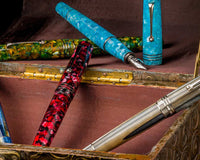When writing with fountain pens, it is fair to expect a certain amount of consistency. After all, it is such a well-engineered tool for writing that you’d expect nothing less than the best results. This is especially true when you get into the finer details. When using fine or extra fine nibs, it is natural to look for precision and exactness.
However, not all nibs are created equally. Here, we’ll talk about the nuances of nibs, specifically, why line widths seem to differ so much, even if they are meant to be the same size.
It’s all in the brand

The result that you get from one fountain pen brand will almost always vary significantly from that of another brand. By now, you might be familiar with the adage that Western fountain pen nibs run wider than their Eastern counterparts. If you take a closer look at brands within these categories, you’ll also find some other differences, albeit more subtle. For instance, writing with the same ink using a LAMY extra fine nib might not give you exactly the same results or experience as writing with a Pelikan extra fine nib.
Nib softness

Lines will also vary depending on the softness of your nib, which will vary based on the material used. Steel nibs tend to be much harder and less pliable, making them perfect for producing very thin lines. Fountain pen users who write with gold-nibbed pens are familiar with the difference in springiness and smoothness that comes with their softness. These nibs have more give, which means they may produce thicker lines given the right amount of pressure when writing. Even the same-sized nib will have a different writing texture depending on how much gold it uses (e.g., 14k gold and 21k gold nibs).
Nib sizes

When comparing line widths, size definitely matters. One of the best examples of this is the comparison between Pelikan fountain pens, specifically their Souverän series. Take the M600 and the M800 models, which both have extra fine, fine, medium, and broad nib selections. Right off the bat, you’ll notice how the M600’s 14k gold nib is shorter and thinner compared to the M800’s 18k nib. This difference in size may also point to a larger feed and therefore, a larger ink capacity. Pens with a greater flow such as the M800 Souverän lay down wetter and more saturated lines, which can also lead to thicker line widths when writing.
Bear in mind that various ink brands will also have different wetness to them. Drier inks like J. Herbin will usually produce thinner lines, while wetter inks like Pilot’s Iroshizuku line will create wider, thicker lines.
Ink-pen-paper combinations

Lastly, the combination of what pen, ink, and paper you’ll use will determine how thin your lines will write. Paper choice also plays a significant role here. Trying fountain pen-friendly paper that holds ink on the surface (like Tomoe River) will help you produce finer lines than more absorbent papers like Midori.
The Bottom Line
When it comes to line width, the sheer variety of factors that can affect it can be a little overwhelming at first. But part of the joy of writing with fountain pens is going through the process.
You might find that the paper you use helps create beautiful, thin lines. You may also discover that how long your ink has been sitting in your fountain pen can actually affect the line width ever so slightly! By learning more about the craft through trying different pen, nib, ink, and paper combinations, you can be more in tune with your needs and preferences for writing, resulting in a much more satisfying and fulfilling writing experience.
Happy writing!
By Some Folks at EndlessPens





